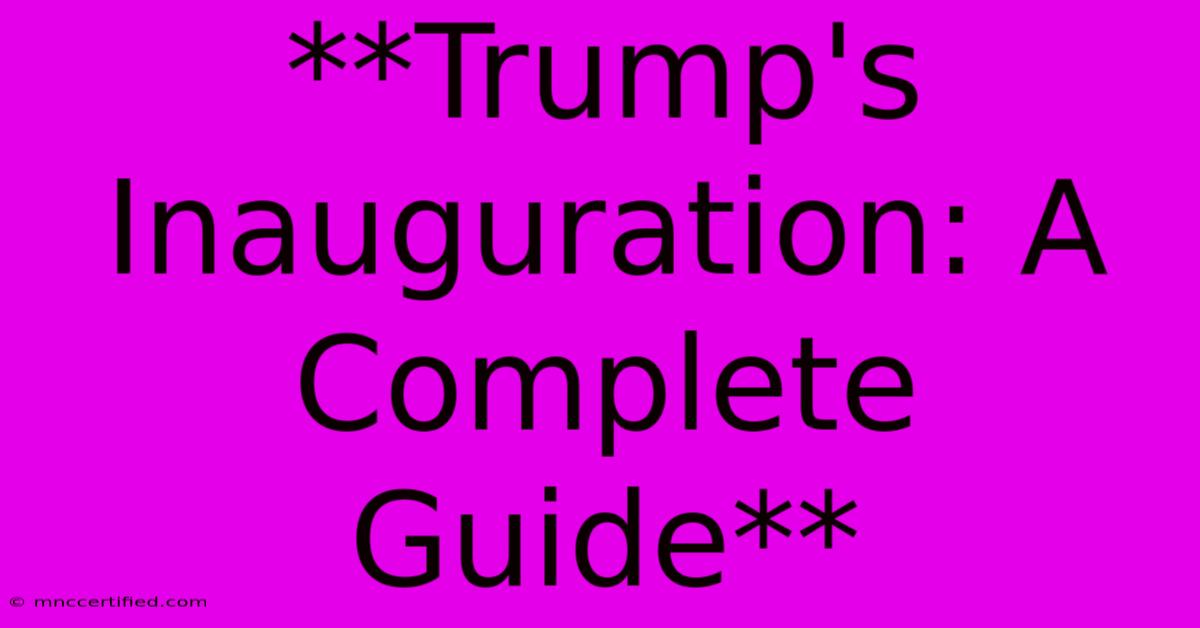**Trump's Inauguration: A Complete Guide**

Table of Contents
Trump's Inauguration: A Complete Guide
On January 20, 2017, Donald Trump was inaugurated as the 45th President of the United States. The event, a milestone in American history, was marked by both celebration and controversy. This guide provides a comprehensive overview of the day's events, highlighting key moments and the context surrounding them.
The Ceremony: A Day of Transition
The inauguration ceremony, held on the West Front of the United States Capitol, was a spectacle of pomp and ceremony. Thousands of people gathered to witness the transfer of power, a moment that traditionally symbolizes the peaceful continuity of the American government.
Key Moments:
- The Swearing-In: Chief Justice John Roberts administered the oath of office to Trump, officially making him the President of the United States.
- Trump's Inaugural Address: In his speech, Trump outlined his vision for America, emphasizing themes of "American carnage," economic revival, and national security.
- Musical Performances: The inauguration featured performances by various artists, including the Mormon Tabernacle Choir, Jackie Evancho, and the Rockettes.
- Inaugural Parade: Following the ceremony, Trump and Vice President Mike Pence participated in the inaugural parade, which proceeded down Pennsylvania Avenue to the White House.
The Controversies: Protests and Criticism
Trump's inauguration was also marked by protests and widespread criticism. Many Americans, particularly those who opposed Trump's policies and rhetoric, expressed their disapproval through demonstrations and public statements.
Key Issues:
- Anti-Trump Protests: Thousands of people took to the streets of Washington D.C. and other cities across the country to protest Trump's presidency, raising concerns about his divisive rhetoric, policies, and potential impact on American society.
- The Inauguration's Size: The official crowd size at the inauguration was disputed, with Trump claiming a record attendance while independent estimates suggested lower numbers. This controversy fueled accusations of dishonesty and an attempt to downplay the scale of anti-Trump sentiment.
- The Inauguration's Message: Trump's inaugural address and the overall tone of the inauguration were criticized by some as divisive, nationalist, and potentially harmful to the fabric of American democracy.
The Aftermath: A New Era Begins
Trump's inauguration marked the beginning of a new chapter in American politics. His presidency was characterized by a highly polarized political climate, a focus on issues like immigration, trade, and national security, and a significant shift in the country's domestic and foreign policy.
Key Points:
- Policy Changes: Trump's presidency saw the implementation of significant policy changes, including tax cuts, deregulation, and a shift toward protectionist trade policies.
- National Security Focus: Trump's presidency was defined by a strong emphasis on national security, including a focus on combating terrorism, strengthening the military, and renegotiating international agreements.
- Polarization and Division: Trump's presidency was marked by intense political polarization, leading to deep divisions within American society and impacting the country's political landscape for years to come.
Conclusion: A Historical Moment
Trump's inauguration was a significant event in American history. The ceremony marked the transfer of power, but it also highlighted the deep divisions within the country and the challenges facing the incoming administration. The controversies surrounding the event reflected the ongoing debate about Trump's presidency and its impact on American society.

Thank you for visiting our website wich cover about **Trump's Inauguration: A Complete Guide** . We hope the information provided has been useful to you. Feel free to contact us if you have any questions or need further assistance. See you next time and dont miss to bookmark.
Featured Posts
-
Does Insurance Cover Chiropractic Services
Nov 07, 2024
-
How Much Was Invested In Apricot Lane Farm
Nov 07, 2024
-
Wisconsin Bans Affirmative Action By Vote
Nov 07, 2024
-
Forex Trading Website Script Free Download
Nov 07, 2024
-
Uefa Champions League Estrella Roja Vs Barcelona Goals
Nov 07, 2024